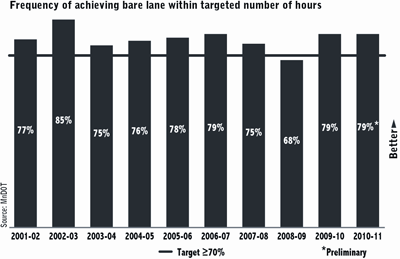Traffic fatalities are declining and bridge conditions are improving, according to the Annual Minnesota Transportation Performance Report released Sept. 28 by the Office of Capital Programs and Performance Measures.
“The report provides measures of various aspects of Minnesota’s transportation system, indicating areas where the system is working well and areas where it is not meeting performance targets,” said Deanna Belden, acting director of measurement.“MnDOT uses this data to make transportation investment decisions.”
The report contains updated performance data and analysis on progress toward the goals of the Minnesota Statewide Transportation Policy Plan 2009-2028. The report also includes measures where MnDOT has primary responsibility, measures where transportation partners play a lead role, as well as tracking indicators to monitor trends.
“Performance data helps ensure we are good stewards of the taxpayer’s dollar and that the investments we make meet the current and future needs of the traveling public,” said Commissioner Tom Sorel.

Source: Annual Minnesota Transportation Performance Report |
The department continues to build on its strengths and is meeting its goals for clearing snow and ice from roads, maintaining safe bridge conditions, providing good pavement quality on major highways and providing statewide travel connections.
State highway pavement condition improved in 2010 due to increased funding from the American Recovery and Reinvestment Act of 2009. To further improve pavement condition, MnDOT initiated in spring 2011 the Better Roads for a Better Minnesota initiative, which will improve more than 700 miles of poor highway pavements during the next four years.
“The Better Roads program is an important example of MnDOT’s response to system performance trends,” Sorel said.
The department has been using performance measurement since the early 1990s to guide investments, measure progress, evaluate trade-offs and stimulate innovation. The department sets targets levels that:
• Reflect the needs of transportation customers
• Assure safety and sound engineering
• Extend the life and minimize the cost of transportation assets
• Support the state’s economy and quality of life
MnDOT’s measures reflect what Minnesotans have said they expect from their transportation system and are similar to those used by other states and USDOT. The report uses 18 performance measures to track progress on nine policy goals:
- Traveler safety
- Infrastructure preservation
- Maintenance
- National and global connections
- Statewide connections
- Twin Cities mobility
- Greater Minnesota metropolitan and regional mobility
- Community development and transportation
- Energy and the environment
MnDOT issued the state’s first transportation performance report in 2008 and has been recognized nationally for excellent transportation performance reporting. To view the 2010 Minnesota Transportation Report, visit www.mndot.gov/measures/. |



